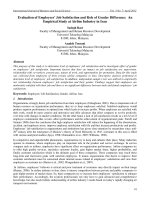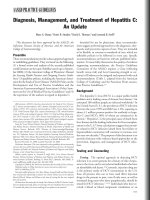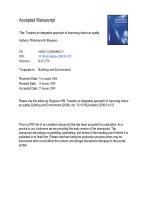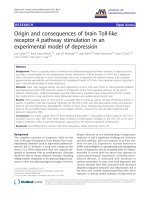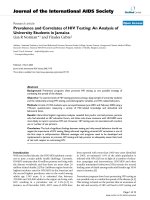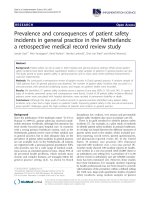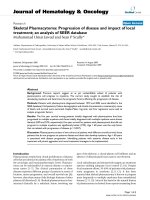Antecedents and consequences of competition towards an integrative view
Bạn đang xem bản rút gọn của tài liệu. Xem và tải ngay bản đầy đủ của tài liệu tại đây (644.42 KB, 164 trang )
Antecedents and Consequences of Competition:
Towards an Integrative View
By
Jie Wu
A dissertation submitted in partial fulfillment
Of the requirements for the degree of
Doctoral of Philosophy
(Business Policy)
in the National University of Singapore
2008
Doctoral Committee:
Associate Professor Nitin Pangarkar, Chair
Professor Kulwant Singh
Associate Professor Albert Teo Chu Ying
ii
To my father
iii
ACKNOWLEDGEMENTS
I would like to thank my dissertation committee: Professor Nitin
Pangarkar, Professor Kulwant Singh and Professor Albert Teo.
Professor Singh provided many insights and introduced me to his
student (Dr Ang Siah Hwee), which proved to be very useful in guiding
me to some of the critical sources for understanding a difficult and
unfamiliar context. I will always appreciate his willingness to serve on
my committee in spite of his extremely busy schedule, and his
willingness to accommodate my demands on his time. To Professor
Nitin Pangarkar, I owe debts in many different forms. From the asking
of an interesting but provable research question, to theoretical
intricacies, to the finer points of academic writing, there is no part of
this dissertation that has not been influenced by my interactions with
Nitin. Without his patience, understanding and unwavering supports
throughout the entire thesis writing process, I would not have
considered or tackled those “simple” ideas. I will always regard him as
one of my best friends and one of the most important supports I have
had. Professor Albert Teo has been a constant source of support. His
willingness to provide powerful software for my data analysis as well
as data, are some of the many ways that Teo helped me. My data
collection has been greatly imprinted by his excellent experimental
design.
Beyond my committee, I thank the many faculty members who
served as teachers and took time out of their schedules to provide
feedback for my ideas or help in thinking through a situation. For
iv
their generous support in this regard I would like to especially thank
Professor Paul Olk. Without an exposure to Professor Olk and the
world that he opened up for me, this dissertation would have been
something quite different and far less interesting. For expanding my
theoretical horizons, and for his careful guidance of my work, I shall
always be indebted to Professor Olk. I would also like to thank
Professor Anand Swaminathan, whose suggestions on theory issues
and econometrics modeling and data manipulation are very useful. I
am grateful for his general willingness to invest his time in providing
insightful comments on my research. I also extend my sincere thanks
to Professor Peter J. Hwang, Professor Kwanghui Lim, Professor Wong
Poh Kam and Professor Andrew Delios for their help, support and
guidance at the different stages of my Ph. D. program.
I thank my colleagues and friends in NUS study, especially
Chaoyi, Hailu and Xufei. From whom, I received many good ideas and
support. Other people who have been invaluable over the past years
include the staff at the Hon Sui Sen Memorial Library. Although the
entire staff has been extremely helpful, I especially appreciate three
people who have constantly gone out of their way to help me, Kah Wei,
Seow Peng, Swee Lian. I also thank Woo Kim for helping me go
through administrative steps easily and for always making my life so
much easier. Jenny and Wendy have been helped me through these
past years and I thank them for their many acts of assistance and
kindness.
v
Finally, I thank the people who have contributed the most to my
life and this dissertation, my family. For their many sacrifices, and
their love and encouragement, I dedicate this dissertation to them.
vi
TABLE OF CONTENTS
DEDICATION ii
ACKNOWLEDGEMENTS iii
LIST OF TABLES ix
LIST OF FIGURES x
LIST OF APPENDICES xi
ABSTRACT 1
CHAPTER 1 INTRODUCTION 2
1.1 Introduction 2
1.2 Conceptual Overview 4
1.2.1 Background and Motivation 4
1.2.2 Theoretical Perspectives 7
1.2.3 Research Design 9
CHAPTER 2: FIRM-LEVEL CAPABILITY-BASED AND EXPERIENCE-
BASED COMPETITOR INDENTIFICATION 12
2.1 Introduction 13
2.2 Theoretical Development 15
2.3 Two Firm-Level Dimensions: Capability and Experience 18
2.3.1 Firm-Level Capability 18
2.3.2 Firm-Level Technological Experience 20
2.4 Hypotheses 22
2.4.1 Firm-Level Capability Affects Competitor Identification 22
2.4.2 Firm-Level Experience Affects Competitor Identification 28
2.5 Data and Methods 31
2.5.1 Data 31
2.5.2 Model Specifications and Econometric Issues 33
2.5.3 Operational measures for independent variables 37
vii
2.5.4 Operational measures for control variables 41
2.6 Results and Robustness Check 46
2.6.1. Results 46
2.6.2 Robustness Check 51
2.7 Discussions 51
2.8 Limitations and Future Directions 57
CHAPTER 3: TOWARD A UNIFIED PERSPECTIVE ON COMPETITION,
COLLBORATION AND INNOVATION 59
3.1 Introduction 60
3.2 Background and Motivation 62
3.2.1 Competition and Innovation 62
3.2.2 Collaboration and Innovation 64
3.3 Conceptual Development 65
3.3.1 Competition as a source of information 65
3.3.2 Collaboration facilitates information exploitation 68
3.3.3 The Interactive Effect of Competition and collaboration 71
3.3.4 Industry context as a contingent factor: High technology industries 73
3.4 Data and Methods 77
3.4.1 Operational measures for the key variables 78
3.4.2 Technological intensity of Industry 80
3.4.3 Control variables 81
3.4.4 Estimation methods 83
3.5 Results and Robustness Check 85
3.5.1 Results 85
3.5.2 Robustness Check 89
3.6 Discussion and Concluding Remarks 90
CHAPTER 4 CONCLUSIONS 94
4.1 Contributions to Theory 94
4.2 Contributions to Management and Strategy 97
4.3 Limitations and Future Research 98
APPENDICES 111
viii
BIBLIOGRAPHY 137
ix
LIST OF TABLES
TABLE 2.1 INDUSTRY, SUB-SECTORS ACTIVITY AND NUMBER OF FIRM
PARTICIPATING BY SUB-SECTORS 100
TABLE 2. 2 CORRELATION MATRIX OF MAIN VARIABLES 101
TABLE 2.3 RESULTS OF ZINB MODELS ESTIMATIONS OF COMPETITORS
REGRESSED AGAINST CAPABILITY 102
TABLE 2.4 RESULTS OF ZINB MODELS ESTIMATIONS OF COMPETITORS
REGRESSED AGAINST TECHNOLOGICAL EXPERIENCE 103
TABLE 3.1 CLASSIFICATION HIGH- MEDIUM- AND LOW-TECH INDUSTRIES 104
TABLE 3.2 DESCRIPTIVE STATISTICS FOR KEY VARIABLES ACROSS SECTORS 105
TABLE 3.3 CORRELATION MATRIX……………………………………………………… 117
TABLE 3.4 MAXIUM LIKELIJOOD ESTIMATES OF ZINB MODELS FOR PATENT
INNOVATION
…………………… ……………………………………………….118
x
LIST OF FIGURES
FIGURE 2.1 THE RELATIONSHIP BETWEEN ORGANIZATIONAL CAPABILITIES AND COMPETITOR
IDENTIFICATION 108
F
IGURE 3.1 THE RECONSTRUCTION OF SOCIAL RELATIONS THROUGH COLLABORATION 109
F
IGURE 3.2 A UNIFIED MODEL OF COMPETITION, COLLABORATION AND INNOVATION 110
xi
LIST OF APPENDICES
APPENDIX 1 WORLD BANK THE STUDY OF COMPETITIVENESS, TECHNOLOGY &
FIRM LINKAGES (MANUFACTURING SECTORS: QUESTIONS FOR THE SENIOR MANAGER
OF THE MAIN PRODUCTION FACILITY OF THE FIRM
) 111
APPENDIX 2 WORLD BANK THE STUDY OF COMPETITIVENESS, TECHNOLOGY &
FIRM LINKAGES (MANUFACTURING SECTORS: QUESTIONS FOR THE FIRM'S
ACCOUNTANT AND/OR PERSONNEL MANAGER ) 126
1
ABSTRACT
In this study, I examine the antecedents and consequences of
competition. The first essay, in the dissertation, builds upon the
Resource Based View and cognitive approach to competition with the
motivation of understanding the antecedents of competition. This essay
proposes two firm-specific, theoretical-based dimensions: organizational
capability and organizational experience and hypothesizes that these two
vital firm-specific dimensions will influence a firm’s view of competition.
The research on the antecedents of competition in the first essay is
extended to the consequences of competition in the second essay.
Building on the concepts developed in the first essay, I propose a
conceptual model of competition, collaboration and innovation and
explore the interactive effect of competition and collaboration and
innovation performance. My study contributes to competitor
identification and bridges the literature on cognitive competitive mapping
and the Resource-Based view, and also contributes to the consequences
of competition by unraveling the interactive effect of competition,
collaboration on innovation.
2
CHAPTER 1 INTRODUCTION
1.1 Introduction
The study of competition occupies a central position in strategic
management research. In this dissertation, I adopt the perspective of the
management of a focal organization and examine the antecedents and
consequences of competition. I ask two questions: (1) How do a firm’s
capability and experience affect competitor analysis in general and
competitor identification
1
in particular? (2) Do particular combinations of
competition and collaboration result in better innovation performance?
The first essay, in the dissertation, builds upon the Resource
Based View and cognitive approach to competition with the motivation of
understanding the antecedents of competition. This essay proposes two
firm-specific, theory-based dimensions: organizational capability and
organizational experience. I hypothesize that these two vital firm-specific
dimensions will have significant cognitive implications for competition—
they will influence firm’s view of competition.
The research about the antecedents of competition in the first
essay is closely related to the central research question in the second
essay. Specifically, building on the concepts developed in the first essay,
the second essay deals with the consequences of competition that
represent the classic issue concerning strategic behaviors and outcomes.
1
Competitor identification is the initial step of competition (Clark and Montgomery,
1999).
3
The purpose of the second essay is to propose a unified perspective to
competition, collaboration and innovation and explore the interactive
effect of competition and collaboration on innovation performance (See
Figure 1.1).
Figure 1.1 A Framework of the Antecedents and Consequences of Competition
I use survey data about Chinese firms to test the key aspects of my
arguments. I estimate two sets of equations to test my hypotheses. The
first set of estimations relates an organization’s capability and experience
to its competitor identification and tests the hypotheses that an
organization’s capability and experience shape its competitor
identification. The second set of estimations relates a firm’s competition
and collaboration network to its innovation performance and tests the
Capability
Experience
Competition
Network
Essay II
Essay I
Innovation
4
hypothesis that the interaction between competition and collaboration
would have significant impact on firm innovation performance.
1.2 Conceptual Overview
1.2.1 Background and Motivation
Several streams of research have addressed, directly or indirectly,
the question of competition. Early studies in the economics area have
held that all firms are equivalent each firm is assumed to compete for
the same scare resources and to contribute to and experience
competition equally (Winter, 1990: 289). This assumption has been
challenged by strategic group researchers who have drawn extensively
from industrial organization (IO) economics (Porter, 1980) and proposed
the concept of strategic groups essentially an industry substructure, to
explain intra-industry variations in the competitive groups and
performance of firms. The strategic group approach has explored whether
firms within competitive groups tend to be more similar in form, practice,
strategy, and the managerial beliefs than firms in different competitive
groups (Reger and Huff, 1993). Organization ecologists challenge
strategic group approach to competition by emphasizing the principle of
competitive exclusion. The greater the similarity of two resource-limited
competitors, the less feasible it is that a single environment can support
both of them in equilibrium (Hannan and Freeman, 1977: 943). The form
5
with any adaptive advantage over the other in obtaining resources will
eventually eliminate the other if it (latter) persists in using its original
form (Aldrich, 2006: 66).
Partly in an effort to respond to such challenges, a growing
number of scholars have begun investigating competition from a
cognitive viewpoint (e.g. Dess & Davis, 1984; Gripsrud & Gronhaug,
1985; Walton, 1986). According to this emerging body of theory,
competition is “a tangible social construction” defined by actors involved.
In this view, an industry has sub-groups of firms that consider each
other as competitors and monitor each other’s actions. Similar to the
notion of oligopolistic markets, firms are more likely to respond to a
competitive move initiated by a member of their sub-group rather than a
firm outside the sub-group. Firms construct an “account of the world” or
“frames of comparability” to reduce uncertainty as well as simplify
information gathering and processing and to focus strategic and resource
commitments (Porac et al., 1995). Strategists’ cognitive structures will
have a material effect on strategic choices and can be expected to
influence industry evolution (Reger & Huff, 1993). Cognitive approach to
competition represents an important shift from objective, researcher-
defined competition to subjective, actor-centered construction of
competition. I keenly observe this shift and deeply root this study in the
new direction of competition research.
6
The cognitive approach, however, has been criticized as “having a
high degree of abstraction” and few attempts have been made to relate
cognitive approach to competition to other variables of theoretical
interest (e.g. competitive strategies and outcomes) (Zahra and Chaples,
1993; Hodgkinson, 1997a). This study aims to link cognitive approach to
competitive strategies (e.g. collaboration) and outcomes (e.g. innovation
output).
Moreover, majority of researchers adopting the cognitive approach
“have concentrated their efforts at a given level of analysis within
particular studies, initially at the level of the industry, with a view to
identifying shared belief structures of competitive space, but more
recently at the level of the individual research participants, with a view to
exploring patterns of similarity and diversity within and between
particular subgroups of research participants.” (Hodgkinson, 1997a) In
contrast, the Resource Based view focuses on firm-level analysis and
suggests that firms’ capability and experience are acquired over a period
of time and they may be attributable to the sequence of resource
allocation decisions (Wernerfelt, 1984; Barney, 1991; Conner, 1994;
Peteraf, 1993). There may also be path dependencies in the process
which mean that an imitator with similar resource allocation decisions
may not end up with a similar bundle of resources (Rumelt, 1987). Thus,
the Resource Based View provides a very unique perspective to
understand competition. I subscribe to the Resource Based View and
7
highlight the interpretive role of “actor-centered” analysis in exploring
competition “firm-based” competition.
However, the Resource Based View mainly focuses on the sources
and maintenance (specifically sustainability) of competitive advantage.
Therefore, it seldom addresses the antecedents and consequences of
competition. This study moves beyond the Resource Based View’s focus
on competitive advantage to analyze the antecedents and consequences
of competition and comprehensively illustrate the whole process of
competition. Therefore, this study addresses the drawbacks of the
Resource Based View and demonstrates the importance and necessity of
explaining dynamic process of competition using the Resource Based
View.
1.2.2 Theoretical Perspectives
The relationship between environments and organizations have
been discussed and debated by scholars (Aldrich and Ruef, 2006; Aldrich
2007; Child, 1972). The extensive research can be divided into two
perspectives. One perspective treats environment as a source of
information used directly by decision makers as the basis for modifying
structure and activities. The main concerns of theorists adopting this
perspective are with decision processes and with the conditions under
which information is perceived and interpreted (Aldrich, 2007). The
second perspective treats environments as consisting of resources sought
8
by populations of organizations. The main concerns of theorists adopting
the latter perspective are with selection process of environment among
the various alternatives—e.g., the organizational form best fitting the
existing conditions (Yuchtman and Seashore, 1976).
The central theoretical perspective of this study subscribes to the
first perspective by relying heavily on theories of perceptions, cognition,
and decision-making, focusing on environments as seen through the eyes
of decision-makers. The view of environments as source of information
directs our attention immediately to the role of perception. As Blumer
(1966: 542) argued “since action is forged by the actor out of what he
perceives, interprets, and judges, one would have to see the operating
situation as the actor sees it, perceive objects as the actor perceives them,
ascertain their meaning in terms of the meaning they have for the actor,
and follow the actor’s line of conduct as the actor organizes it in short,
one would have to take the role of the actor and see the world from his
standpoint.”
The information perspective actually identifies a two-step process
that posits that information about environmental elements pass through
the filtering, and the filtered information then is integrated into the frame
of reference of decision-makers. Dill (1958) placed emphasis on
organizations as information-processing systems and on the way
organizations learn about their environments. It is important to note that
Dill’s model is not a pure rational selection model, for he also stressed
9
constraints on information processing and gaps in the learning process
(Dill, 1958). This study extends Dill’s view by (1) highlighting two firm-
specific, theory-based dimensions organizational capability and
organizational experience and their constraints on information-
processing and (2) specifying competition as an interpretation of
environment by decision-makers affecting firm strategic choices (e.g.
collaboration), in turn influencing innovation outcome.
The survey data used in the study includes senior managers’
perception of competitive environments, firms’ characteristics, external
collaboration, innovation performance, which provides a good context to
test my hypotheses. Specifically, I examine how information about
environmental elements passes through the focal firm in Chapter II, and
examine how the filtered information affects firms’ strategic decision (e.g.
strategic collaboration), resulting in firm innovation performance in
Chapter III.
1.2.3 Research Design
The hypotheses were tested using a survey conducted by the World
Bank in collaboration with the Enterprise Survey Organization of the
Chinese National Bureau of Statistics under a project entitled The study
of competitiveness, technology and firm ventures, to test the key aspects
of my arguments. The questionnaires were designed by economists of
Development and Research Group, the World Bank. The World Bank and
10
Chinese National Bureau of Statistics collaborate to survey 300 firms in
each of five cities Beijing, Chengdu, Guangzhou, Shanghai and Tianjin
for a total of 1,500 Chinese firms. Each firm was asked to assign a
senior manager, who could accurately interpret his/her own firm’s
financial situation, and collaboration network and environments, to
respond to the questionnaires. Accounting for the alternative explanation
from Upper Echelon theorists (Hambrick and Mason, 1984), I included
Top Management Team demographic characteristics (for instance average
TMT education, average TMT gender ratio, average TMT age, average TMT
turnover rate, average TMT internationalization) in the empirical analysis.
The China market provides an ideal research context for this study,
because China is the largest and the fastest growing emerging economy,
with substantially different market setting from Western countries (Luo,
2001). It has become the second largest FDI recipient country, just next
to U.S (UNCTAD, 2007). Clearly, China since its opening policy in 1979
has been characterized by a change from stable environment to the
highly uncertain and dynamic environment. While almost all the largest
multinational corporation have entered China market, 23 Chinese firms
from China (including Hong Kong and Taiwan) have been listed as top
500 companies, of which there are 19 Chinese firms from mainland
China (Fortune 2006). The transitioning institutions have further
increased environmental variation, which provides an appropriate setting
to examine the antecedents and consequences of firm-based competition.
11
I use two sets of models to test my hypotheses: logistic models and
Zero-inflated Negative Binomial (ZINB) models. The logistics models are
used to estimate those equations with dependent variable taking dummy
variable. Zero-inflated Negative Binomial models are used to address
special problems of dependent variables taking count variable. I employ
robust Maximum Likelihood Estimates (MLE) to calculate the standard
errors based on the primary sampling unit (i.e., industry-level are
jurisdiction in my data) rather than individual observation. Robust MLE
does not change the point estimates, but it ensures unbiased standard
errors.
12
CHAPTER 2: FIRM-LEVEL CAPABILITY-BASED AND EXPERIENCE-
BASED COMPETITOR INDENTIFICATION
ABSTRACT
This essay investigates the relationship between firm-level
capability and experience and competitor identification. I argue that firm-
level of capabilities and experience will each have a significant impact on
competitor identification. Empirical evidence provides support for
examining sources of firm-level heterogeneity to understand competitor
identification. My findings contribute to competitor identification and
bridge cognitive competitive mapping and the Resource-Based view.
13
2.1 Introduction
Competitor identification, as part of the broader topic of competitor
analysis, occupies a central position in organizational research because
it helps managers formulate appropriate strategy and it is always too late
to respond when a firm realizes that its market is being attacked from
other competitors. Several streams of research have addressed directly or
indirectly the importance of competitor identification and its sources (e.g.,
Porac et al., 1989; Clark and Montgomery, 1999; Hodgkinson 1997a;
Lant and Baum, 1997; McNamara, Deephouse and Luce, 2003; Peteraf
and Shanley, 1997; Stinchcombe 1965; Walker, Kapelianis and Hutt,
2005; Zahra and Chaples, 1993). While numerous studies have taken an
externally, or objectively, defined approach, based mostly upon industry
or population membership, more recently there has been a focus on
defining the competitors based upon top management’s perceptions.
Strategic group researchers have drawn extensively from managerial
cognition, which holds that decision makers’ perceptions and cognition
are phenomena that can be expected to influence industry evolution
(Reger and Huff, 1993). Managers create models of the industry by
grouping together organizations that are similar on important
characteristics (Porac and Thomas, 1990) and “market boundaries are
14
socially constructed around a collective cognitive model that summarizes
typical organizational forms with an industry” (Porac et al., 1995, p. 203).
Common to most of these approaches is that the researchers use
cognitive mapping to categorize companies into different groups and that
these individual mental models develop into “stable, commonly shared
beliefs regarding firm capability and patterns of competition within an
industry” (Thomas and Pollock, 1999, p. 136). However, several
fundamental questions about competitor identification remain
unexplored. The focus on the similarity among different firms in terms of
their view of competition has overlooked specific features of organizations
that may lead to differences. These differences are important because
they may not only affect the firm’s view of competition but require that
‘the identification of competitors must proceed from a firm-level
perspective’ (Peteraf and Bergen, 2003, p. 1030). This leads us to ask,
how do a firm’s characteristics affect its competitor identification? If
capability and experience are often considered a source of distinction
between firms, do firm’s capability and experience lead to different
perceptions of competitive set? This study explores these questions by
focusing on competitor identification, the first step in conducting a
competitor analysis. I introduce two firm-specific, theory-based
constructs for explaining competitor identification: capability-based
mechanism and experience-based mechanism. The two firm-specific
constructs on competitor identification will help to reveal the conceptual
